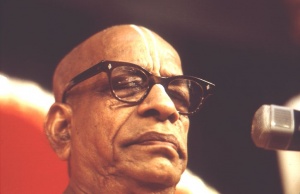CC Madhya 19.211: Difference between revisions
m (1 revision(s)) |
(Vanibot #0054 edit - transform synonyms into clickable links, which search similar occurrences) |
||
| (One intermediate revision by one other user not shown) | |||
| Line 1: | Line 1: | ||
{{ | [[Category:Sri Caitanya-caritamrta - Madhya-lila Chapter 19|C211]] | ||
<div style="float:left">'''[[Sri Caitanya-caritamrta|Śrī Caitanya-caritāmṛta]] - [[CC Madhya|Madhya-līlā]] - [[CC Madhya 19|Chapter 19: Lord Śrī Caitanya Mahāprabhu Instructs Śrīla Rūpa Gosvāmī]]'''</div> | |||
<div style="float:right">[[File:Go-previous.png|link=CC Madhya 19.210|Madhya-līlā 19.210]] '''[[CC Madhya 19.210|Madhya-līlā 19.210]] - [[CC Madhya 19.212|Madhya-līlā 19.212]]''' [[File:Go-next.png|link=CC Madhya 19.212|Madhya-līlā 19.212]]</div> | |||
{{CompareVersions|CC|Madhya 19.211|CC 1975|CC 1996}} | |||
{{RandomImage}} | |||
==== TEXT 211 ==== | ==== TEXT 211 ==== | ||
<div | <div class="verse"> | ||
śānta-rase—‘svarūpa-buddhye kṛṣṇaika-niṣṭhatā’ | :śānta-rase—‘svarūpa-buddhye kṛṣṇaika-niṣṭhatā’ | ||
“śamo man-niṣṭhatā buddheḥ” iti śrī-mukha-gāthā | :“śamo man-niṣṭhatā buddheḥ” iti śrī-mukha-gāthā | ||
</div> | </div> | ||
| Line 12: | Line 16: | ||
==== SYNONYMS ==== | ==== SYNONYMS ==== | ||
<div | <div class="synonyms"> | ||
śānta- | ''[//vanipedia.org/wiki/Special:VaniSearch?s=śānta&tab=syno_o&ds=1 śānta]-[//vanipedia.org/wiki/Special:VaniSearch?s=rase&tab=syno_o&ds=1 rase]'' — in the stage of ''śānta-rasa'', or neutrality; ''[//vanipedia.org/wiki/Special:VaniSearch?s=svarūpa&tab=syno_o&ds=1 svarūpa]-[//vanipedia.org/wiki/Special:VaniSearch?s=buddhye&tab=syno_o&ds=1 buddhye]'' — by self-realization; ''[//vanipedia.org/wiki/Special:VaniSearch?s=kṛṣṇa&tab=syno_o&ds=1 kṛṣṇa]-[//vanipedia.org/wiki/Special:VaniSearch?s=eka&tab=syno_o&ds=1 eka]-[//vanipedia.org/wiki/Special:VaniSearch?s=niṣṭhatā&tab=syno_o&ds=1 niṣṭhatā]'' — full devotion to the lotus feet of Kṛṣṇa; ''[//vanipedia.org/wiki/Special:VaniSearch?s=śamaḥ&tab=syno_o&ds=1 śamaḥ]'' — equilibrium; ''[//vanipedia.org/wiki/Special:VaniSearch?s=mat&tab=syno_o&ds=1 mat]'' — to Me; ''[//vanipedia.org/wiki/Special:VaniSearch?s=niṣṭhatā&tab=syno_o&ds=1 niṣṭhatā]'' — the quality of attachment; ''[//vanipedia.org/wiki/Special:VaniSearch?s=buddheḥ&tab=syno_o&ds=1 buddheḥ]'' — of the mind; ''[//vanipedia.org/wiki/Special:VaniSearch?s=iti&tab=syno_o&ds=1 iti]'' — thus; ''[//vanipedia.org/wiki/Special:VaniSearch?s=śrī&tab=syno_o&ds=1 śrī]-[//vanipedia.org/wiki/Special:VaniSearch?s=mukha&tab=syno_o&ds=1 mukha]'' — from the mouth of the Supreme Lord; ''[//vanipedia.org/wiki/Special:VaniSearch?s=gāthā&tab=syno_o&ds=1 gāthā]'' — a verse. | ||
</div> | </div> | ||
| Line 19: | Line 23: | ||
==== TRANSLATION ==== | ==== TRANSLATION ==== | ||
<div | <div class="translation"> | ||
“When one is fully attached to Kṛṣṇa’s lotus feet, one attains the śamatā stage. The word ‘śamatā’ is derived from the word ‘śama’; therefore śānta-rasa, the position of neutrality, means being fully attached to the lotus feet of Kṛṣṇa. This is the verdict from the mouth of the Supreme Personality of Godhead Himself. This state is called self-realization. | “When one is fully attached to Kṛṣṇa’s lotus feet, one attains the śamatā stage. The word ‘śamatā’ is derived from the word ‘śama’; therefore śānta-rasa, the position of neutrality, means being fully attached to the lotus feet of Kṛṣṇa. This is the verdict from the mouth of the Supreme Personality of Godhead Himself. This state is called self-realization. | ||
</div> | </div> | ||
| Line 26: | Line 30: | ||
==== PURPORT ==== | ==== PURPORT ==== | ||
<div | <div class="purport"> | ||
The corresponding verse from the Bhakti-rasāmṛta-sindhu (3.1.47) follows. | The corresponding verse from the ''Bhakti-rasāmṛta-sindhu'' (3.1.47) follows. | ||
</div> | </div> | ||
__NOTOC__ | |||
<div style="float:right; clear:both;">[[File:Go-previous.png|link=CC Madhya 19.210|Madhya-līlā 19.210]] '''[[CC Madhya 19.210|Madhya-līlā 19.210]] - [[CC Madhya 19.212|Madhya-līlā 19.212]]''' [[File:Go-next.png|link=CC Madhya 19.212|Madhya-līlā 19.212]]</div> | |||
__NOTOC__ | |||
__NOEDITSECTION__ | |||
Latest revision as of 22:28, 19 February 2024

A.C. Bhaktivedanta Swami Prabhupada
TEXT 211
- śānta-rase—‘svarūpa-buddhye kṛṣṇaika-niṣṭhatā’
- “śamo man-niṣṭhatā buddheḥ” iti śrī-mukha-gāthā
SYNONYMS
śānta-rase — in the stage of śānta-rasa, or neutrality; svarūpa-buddhye — by self-realization; kṛṣṇa-eka-niṣṭhatā — full devotion to the lotus feet of Kṛṣṇa; śamaḥ — equilibrium; mat — to Me; niṣṭhatā — the quality of attachment; buddheḥ — of the mind; iti — thus; śrī-mukha — from the mouth of the Supreme Lord; gāthā — a verse.
TRANSLATION
“When one is fully attached to Kṛṣṇa’s lotus feet, one attains the śamatā stage. The word ‘śamatā’ is derived from the word ‘śama’; therefore śānta-rasa, the position of neutrality, means being fully attached to the lotus feet of Kṛṣṇa. This is the verdict from the mouth of the Supreme Personality of Godhead Himself. This state is called self-realization.
PURPORT
The corresponding verse from the Bhakti-rasāmṛta-sindhu (3.1.47) follows.